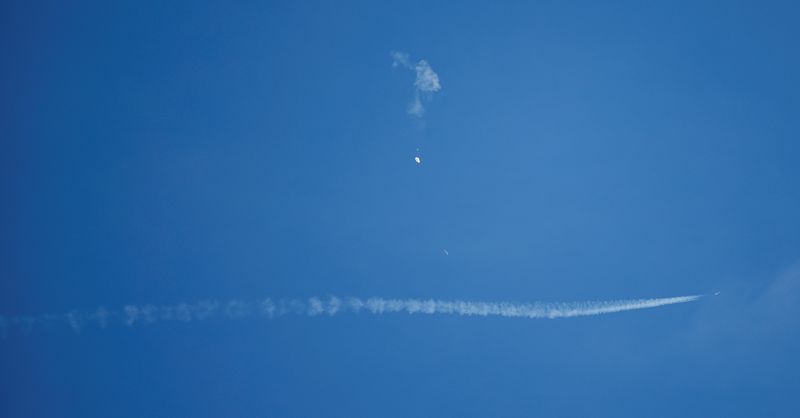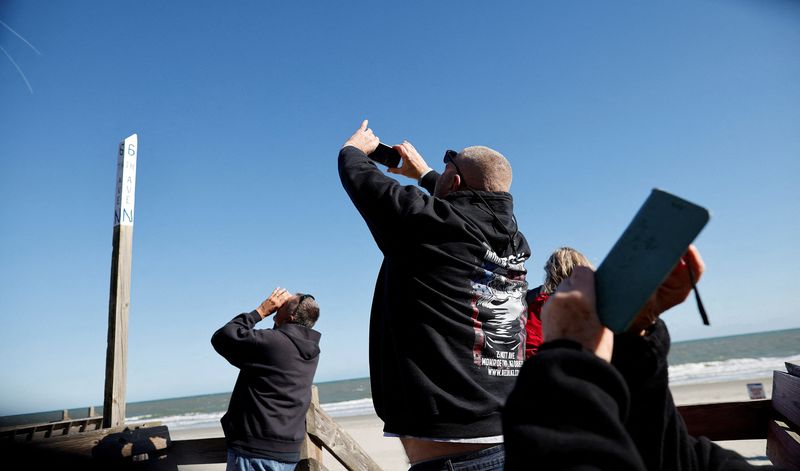By Phil Stewart and Jeff Mason
WASHINGTON (Reuters) - When China's suspected surveillance balloon first passed into U.S. airspace north of Alaska's Aleutian Islands on Jan. 28, American officials believed there was a good chance it would keep traveling on a northern trajectory over sparsely populated areas.
But two days later the balloon did something unexpected: it slowed down, almost loitering, over Canada. Then it changed course and headed south on a new trajectory that would eventually take it over the U.S. state of Idaho, officials said.
"That's when we knew this was different," a U.S. official said, speaking on condition of anonymity.
Chinese spy balloons have crossed into U.S. territory in the past but the way that this one maneuvered, steering toward sensitive U.S. sites, raised alarms at the North American Aerospace Defense Command (NORAD), officials said.
The United States operates a military base and nuclear missile silos in Montana, a state bordering Idaho.
The appearance of the Chinese balloon caused a political uproar in the United States and prompted the top U.S. diplomat, Antony Blinken, to cancel a Feb. 5-6 trip to Beijing that both countries hoped would steady their rocky relations.
President Joe Biden asked for military options on Tuesday to deal with the growing - but still undisclosed - crisis.
Military officials developed a plan to shoot down the balloon on Wednesday as it flew over Montana.
Planning advanced to the point where Billings airport on Wednesday issued a ground stop to clear nearby airspace as the military mobilized F-22 fighter jets in case Biden ordered that the balloon be shot down.
"Even with those protective measures taken it was the judgment of our military commanders that we didn't drive the risk down low enough, so we didn't take the shot," a senior U.S. defense official told reporters on Thursday.
Another U.S. military official, speaking on condition of anonymity, said the debris would have fallen at least in a seven-mile (11-km) radius, posing a mortal risk to Americans and potentially damaging infrastructure.
The best and safest option was instead to take the balloon down over water, officials concluded, a move that could also help U.S. intelligence recover the Chinese equipment for study.
BALLOON MANEUVERS
The U.S. government has declined to say which sites the Chinese balloon surveyed. It appeared to travel near sensitive U.S. bases including Malmstrom Air Force Base in Montana, which oversees 150 intercontinental ballistic missile silos, and Offutt Air Force Base in Nebraska, home to U.S. Strategic Command, which is in charge of nuclear forces.
It also appeared to drift over Whiteman Air Force Base in Missouri, which operates the Air Force's B-2 bomber.
One U.S. official, speaking on condition of anonymity, said the balloon was able to linger in the winds over specific areas.
"We saw it do that. It loitered over certain sites. It went left, right. We saw it maneuver inside the jet stream. That's how it was operating," the official said, adding that the craft had propellers and rudders.
China says the balloon was a civilian craft used for meteorological and other purposes, and strayed into U.S. airspace "completely accidentally."
On Wednesday, U.S. Secretary of State Antony Blinken and Deputy Secretary Wendy Sherman met with senior officials from the embassy of China to convey "a strong set of messages," a senior administration official said.
Biden had already directed his team to protect sites from Chinese collection of sensitive information as NORAD tracked the balloon's movements across the continental United States.
The United States also started gathering information about the balloon itself, including how it operated.
After sightings along the balloon's path, and public uproar swelled, Blinken decided on Thursday to officially postpone his trip to China, according to an administration official. On Friday, the Pentagon said it expected the balloon to keep flying over the United States for several more days.
SHOOT DOWN PREPARED
But after those public remarks, the balloon gathered speed, heading toward South Carolina's coast. Officials said it wasn't clear how much of that acceleration was due to the jet stream or the use of the balloon's own steering.
Biden approved a plan to shoot down the balloon on Friday night while he was in Wilmington, Delaware, setting off round-the-clock military preparations to coordinate the mission.
NASA analyzed and assessed the debris field, based on the trajectory of the balloon, weather and estimated "payload" of sensors, and a U.S. military operation unfolded at sea and in the skies.
Multiple fighter and refueling aircraft joined the mission to take down the Chinese balloon, but only one - an F-22 fighter jet from Langley Air Force Base in Virginia - took the shot at 2:39 p.m. (1939 GMT), using a single AIM-9X Sidewinder missile.
It punctured the balloon as it hovered at between 60,000 and 65,000 feet (18-20 km), and the payload came crashing down to the sea. The debris field stretched for some seven miles (11 km), as predicted, but most landed in relatively shallow water, just 47 feet (14 metres) deep.
"That will make it fairly easy, actually," a military official said of the recovery operation in the Atlantic.

Once the mission was complete, the U.S. government notified China while the State Department briefed American allies.
China condemned the action, saying America was "obviously overreacting."
